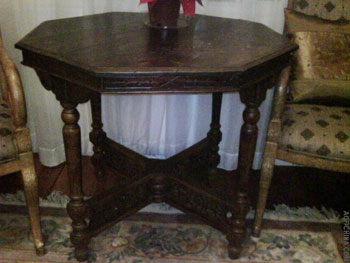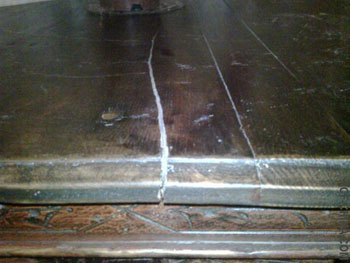shop by
Categories
Repairing Oriental Furniture

Question:
A reputable local antique Chinese furniture dealer sold us this nice Chinese table. It cracked a few months after getting it. He has his own shop to produce furniture as well as sell antiques. Here are two photos, one of the side of the table, and one of the whole thing. So there are really two large cracks in this poor beautiful old table. Can it be repaired rather than replace the top?
Answer:
Its hard to tell exactly from the photos (which are not so clear) but from what I can see, it looks like this is a colonial old Shanghai (also known as Lao Shanghai) art deco style table. The sides seem missing as normally this style of table has four "pointed" corner plates on the sides which when pulled up/opened (kind of like a drop leaf table) make the table square instead of hexagonal. Maybe they were missing when the item was collected in un-restored form, or maybe it was just too much trouble to replace/repair them. Who knows. Also, again, its hard to tell from the photos but I think there are probably a number of portions of this piece which are completely new, though I cannot say at what percent without clearer photos. One of the legs "feels" new. I have seen the delicate tops buckle sometimes on un-restored colonial style tables over time, so it would not be surprising if it needed to be repaired during restoration and this is where the problem seems to have occurred. Repairs are normal for this sort of furniture and whats important is not the repair but rather how it was repaired. Seems the issue with the cracked and split top, is that when the top was repaired, in a few places it seems that new wood replacement boards (glued together) were used, instead of using properly dried wood, old aged wood or reclaimed wood. In door environments, in particular where dry electric heat is used can accelerate this sort of cracking.
 That's probably why the cracking occurred as the wood was still moist and not fully dried. With old and/or reclaimed wood where the wood has had plenty of time to dry this is much less of a problem. The choice of wood used for this section can also have an effect as some woods are more prone to cracking (like pine) then others. Another give away here is the actual edges on the new boards, as well as the patina itself, don't match the rest of the delicate nature of the piece. Notice the thickness? There is also visible saw marks in the new boards. In fact, it might not even be the same species of wood. The grain seems much courser on the new boards. It can be repaired, though the damaged board most likely should be replaced with something a bit more appropriate to the piece and following the recommendations above.
That's probably why the cracking occurred as the wood was still moist and not fully dried. With old and/or reclaimed wood where the wood has had plenty of time to dry this is much less of a problem. The choice of wood used for this section can also have an effect as some woods are more prone to cracking (like pine) then others. Another give away here is the actual edges on the new boards, as well as the patina itself, don't match the rest of the delicate nature of the piece. Notice the thickness? There is also visible saw marks in the new boards. In fact, it might not even be the same species of wood. The grain seems much courser on the new boards. It can be repaired, though the damaged board most likely should be replaced with something a bit more appropriate to the piece and following the recommendations above.


